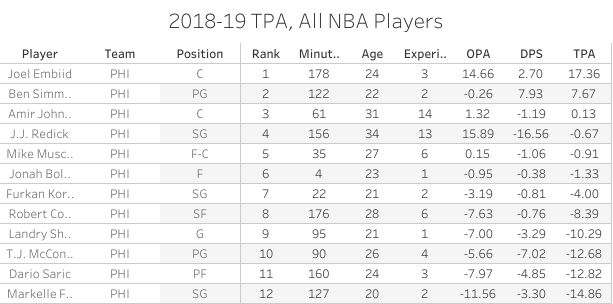
Sixers Math = Not Great
There’s a website called NBAMath.com that charts a statistic called TPA, or “total points added.”
The concept is pretty simple. Basically you combine the parameters of “offensive points added” (OPA) and “defensive points saved” (DPS) to determine a players’ overall contribution to your team on both sides of the floor.
Here’s the latest model for the 76ers:
After their 123-108 loss to the Milwaukee Bucks, the Philadelphia 76ers are now 2-3. Here's how all #HereTheyCome players have fared in TPA during the 2018-19 season: pic.twitter.com/VjcRjMlWPa
— NBA Math (@NBA_Math) October 25, 2018
JJ Redick: adding a lot of points but not saving a lot of points.
Joel Embiid: adding points and playing well defensively.
Ben Simmons: a better defender than most people realize.
Unfortunately you see Markelle Fultz not really contributing much of anything.
His DPS is okay, but his OPA is poor, which results in the team’s worst TPA total, as you can see below:
We’re just five games in, so you’d hope his numbers trends in the opposite direction sooner rather than later. And Dario Saric has been a big disappointment early on. The Sixers currently rank 18th in the NBA in defensive rating and finished 3rd in that category last season, so that’s really been the overall killer so far.
Here’s more on how NBA Math does their calculations:
“OPA is derived by adjusting offensive box plus/minus (OBPM) to account for the number of possessions the player in question is present for. Similarly, DPS is derived from a similar adjustment of defensive box plus/minus (DBPM) with that same number of possessions. OBPM and DBPM, both calculated by Basketball-Reference.com, estimate the per-100-possessions value of a player on either end of the court.
Add OPA and DPS together, and you have TPA. A score of zero indicates a player was perfectly average (by no means a bad thing for rookies or lifelong end-of-bench players), while anything positive means they were better than an average-level replacement.”
This has been your analytics and statistics minute.
Reporting for Crossing Broad, I’m Matt Klentak.






